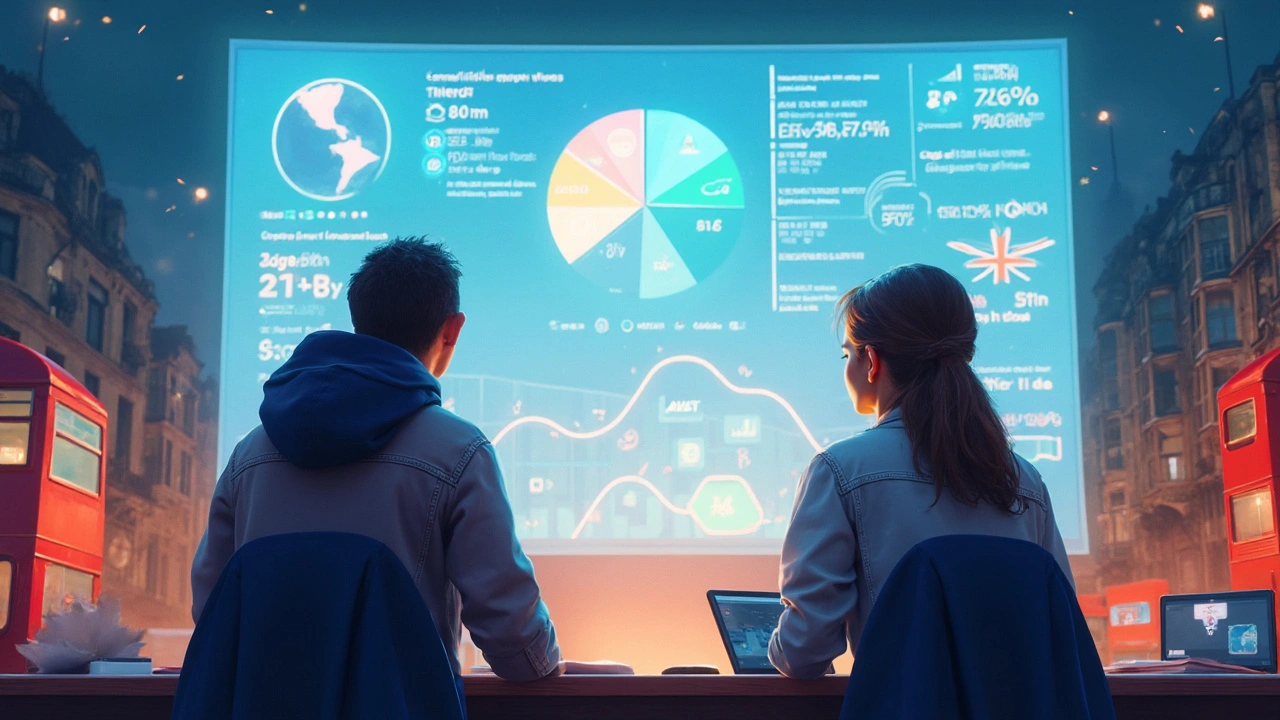ChatGPT for Online Marketing: Game-Changing Strategies & Tools

On the surface, online marketing looks like a game where only those with fat budgets or big teams can win. But then along comes ChatGPT—this AI powerhouse has turned the game upside down. It writes, plans, and analyzes like a machine (well, because it is), but it doesn't just spit out robotic text. It crafts messages that sound real, understands slang, and even gets jokes. Imagine a tool that doesn’t sleep, needs zero coffee, and can draft a month's worth of content before your next break. The kicker? It's available to anyone, not just the tech giants or folks swimming in cash. Marketers everywhere are already sliding it into their workflow, and those who aren’t get left behind faster than yesterday’s hashtags. Let’s break down exactly how ChatGPT is shaking up online marketing—and how you can use it to get ahead.
The Secret Sauce: Why ChatGPT is Turning Heads in Marketing
You want your brand at the top of every feed but budgets are tight, deadlines are insane, and, let’s be honest, original ideas are hard to come by. Here’s where ChatGPT kicks in. Back in 2022, when OpenAI opened the digital gates, few predicted that in just three short years, companies big and small would be leaning on AI—especially ChatGPT—for their daily marketing grind. We're not just talking about basic stuff like blog outlines. ChatGPT can bang out ad copy, e-commerce product lines, email sequences, FAQ answers, and even come up with viral TikTok prompts. The real magic? It adapts to your brand voice. You can ask, “Make this relaxed and quirky,” or “Sound more professional and urgent.” It listens and delivers every time.
The real numbers tell the story. According to a 2024 HubSpot survey, about 67% of marketers used AI tools, mostly ChatGPT, at least twice a week. Copywriters and strategists say it isn’t just about cutting the workload; it snaps ideas into place when you’re stuck. It’ll turn boring sentences into headlines that pop. It can even suggest changes if you paste your existing copy and say, “Make this fit Instagram culture.” You don’t just save money—an estimated 35% time boost for content teams—but you get work that resonates more because the tool is always learning what people actually want to read.
Another surprise: language barriers are mostly gone. Want to launch a product in Spain next month? ChatGPT translates and rewrites all your assets, so they sound local, not like a robot translated from English. One marketer at a major sneaker brand even claimed that ChatGPT saved them several thousand dollars in translation fees alone during a recent international drop. On top of this, the tool stays up to speed with the latest internet slang—no more awkward Gen Z catchphrases or boring, outdated lingo.
There’s also the research angle. Say you need insights about what competitors are doing or what your customers care about this week. Sure, you could spend hours scrolling Reddit, Twitter, and product reviews... or just ask ChatGPT. Feed it links, questions, or even messy notes, and out comes a clean list of key takeaways, trends, and possible campaign angles. It filters out the junk so you spend your time on what actually matters.
So, if you’re still handling all your digital marketing work the way you did in 2019, think about what you’re missing: time, creativity, and reach. ChatGPT isn’t just a nice-to-have. It’s the new secret weapon for brands that want to stay ahead of the curve.

Everyday Uses for ChatGPT in Online Marketing
Open your inbox and count your unread marketing emails. Chances are, most say the same thing—and that’s exactly why standing out matters. ChatGPT is your cheat code for cutting through that noise. Want to nail a subject line that actually gets opened? Prompt ChatGPT for “10 subject lines that boost open rates for a summer shoe sale.” It cranks out options in seconds, some playful, some urgent, all tailored by your specific request. No more blank-screen panic.
Email isn’t the only place the AI shines. A beauty brand in Los Angeles used ChatGPT to overhaul all its product descriptions. The result? A 22% spike in online sales within the first quarter. Not a typo—just better, sharper descriptions that answered what shoppers cared about: ingredients, results, and the feeling of opening a luxury product at home. Before switching to ChatGPT, the brand spent two weeks per season updating copy. Now they wrap the project in two days (freeing up time for, you know, actual marketing). Their trick? Feed ChatGPT old best-selling descriptions, see what makes them tick, then use the tool to create dozens of fresh variants that preserve what works.
Don’t forget strategy planning. Building out social media campaigns can mean hours of hashing out ideas, themes, and hashtags. With ChatGPT, you start the brainstorm in seconds. Ask for “weekly Instagram post ideas for a brand-new eco-friendly swimwear line.” The tool not only generates ideas but adds corresponding hashtags and even suggests influencer tie-ins.
Let’s talk customer service, too. Websites using AI chatbots built on GPT tech are seeing wild improvements. A well-known e-commerce platform chopped their response time by 40% and increased customer satisfaction ratings just by training ChatGPT on common questions, order updates, and refund scenarios. Happy customers mean more repeat business, so the math is obvious. No more sifting through endless chats or emails—let the bot handle FAQs so your humans can focus on tough questions and relationship-building.
Blog posts, video scripts, meta descriptions, press releases—this tool isn’t picky about what it writes. It can even help you create a full content calendar with suggested publish dates and angles based on what’s trending right now. The key is to feed it what’s worked for you before (your best emails, top social posts) so it learns your style. You’re not just saving time; you’re multiplying your creative power.
Need some easy pointers to get started? Here’s what’s working for marketers right now:
- Be specific in your prompts. Don’t just say, “Write a blog post.” Ask for a “1,000-word article targeting new parents about baby sleep routines.”
- Review the results for brand tone. Ask for edits or tweak yourself so everything fits your company’s voice.
- Ask for several versions and pick the best parts. The AI loves variety, so don’t settle for the first draft.
- Use it for quick research. It can round up stats, quotes, and even summarize lengthy articles on your topic.
- Keep training it as you go. The more you interact, the better it gets at understanding your style and needs.
Anyone can use ChatGPT out of the box, but pros get the best results by treating it like a collaborator. Feed it your ideas. Push it, challenge it, ask for more options. Don’t just copy-paste—use it as a launchpad for ideas you wouldn’t have thought of alone.

Tweaking ChatGPT for Better Results: Pro Tips & Ethical Moves
Not every word that pours out of ChatGPT is gold. Sometimes you’ll spot a weird turn of phrase or a fact that needs double-checking. Don’t be shy about editing—think of the AI as a fast-talking intern who sometimes needs a little hand-holding. It’s your job to polish, fact-check, and make sure everything lines up with what your brand stands for. If you overlook this, you risk sounding generic, or worse, getting facts wrong, which can be brutal for your reputation.
If you’re working in a regulated field—like healthcare, finance, or anything related to privacy—be extra careful. ChatGPT is good, but it doesn’t know all the legal must-dos. Always run sensitive drafts by a real expert before publishing. That said, many insurance and legal marketing teams use ChatGPT as an idea-starter or to reword complex explanations, saving time and avoiding heavy jargon. They just make sure a human reviews anything before it goes live.
Let’s talk about training the tool. Most folks just type a prompt and accept what comes out. The magic happens when you feed it examples of your previous best work—top-performing ads, your most shared posts, winning email intros. ChatGPT eats that up and spits out new drafts that match your style every time. Some companies even keep a “brand voice” cheat sheet handy: a few phrases, dos and don’ts, and basic company facts. Paste that in with your prompts, and the AI gets smarter, faster.
The ethical side matters too. Don’t pass off AI-generated content as totally human-created, especially if you run a personal brand or do sponsored posts. Audiences care more than ever about authenticity. You don’t need to shout from the rooftops that you’re using AI, but don’t let your entire brand feel robotic or copy-and-pasted either. The best marketers blend AI and human creativity, then double-check facts and add their unique spin.
Finally, don’t forget to check performance. Split-test your AI-generated campaigns—adversing pros report that emails, ads, or landing pages created or refined by ChatGPT often lead to serious improvements. If an AI-drafted email outperforms your old one by 28% (like what happened at a Silicon Valley software startup this winter), run with it. If something flops, tweak the prompt, feed it new examples, and try again.
As of July 2025, ChatGPT-powered platforms work directly with Google Ads, Shopify, HubSpot, and even TikTok’s campaign managers. Everything syncs up, so you can build, test, and launch campaigns in just a couple of clicks. Have you tested writing hooks for your next YouTube ad? Or crafted a product knowledge quiz for your chatbot? The only limit is your creativity—and how specific you get with what you ask the AI to do.
This year, the brands that shine aren’t the ones with the most cash or the biggest team. It’s the ones using new tech—especially ChatGPT—to work smarter, not harder. Stay sharp, keep experimenting, and use this tool to keep your edge. The digital marketing world has never been more open, or more competitive. You don’t need to outspend the competition—you just need to outthink them. And right now, that means having ChatGPT on your side.



